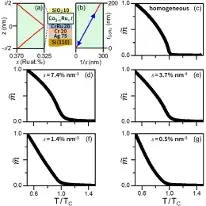Overriding Universality via nano-scale Materials Design
In a recent article published in Physical Review Letters (Phys. Rev. Lett. 127, 147201 (2021)), researchers from the Nanomagnetism group at nanoGUNE in collaboration with scientists from the US and Colombia have demonstrated that it is possible to design thermodynamic critical exponents a la carte and override the universality of phase transition behavior, which was previously understood to be only dependent on the dimensionality of sample and order parameter.

Phase transitions and critical behavior are among the most fascinating phenomena in nature and their exploration inspired the development of many branches of modern science. An excellent example is spontaneous symmetry breaking, which takes place at a critical temperature TC that divides two macroscopic phases distinguished by an order parameter, for which the ferromagnetic-to-paramagnetic phase transition is the most emblematic example. Its description is universal, so that very diverse physical systems that share the same essential symmetries exhibit the same behavior close to TC. This is characterized by a set of critical exponents that depend on the dimensionality of the system and the symmetry of the order parameter. Accordingly, physical systems are categorized in terms of universality classes despite otherwise having vastly different material characteristics. Even though universality is essential for the most relevant scientific advances in this field of research, including the description of complex systems by highly idealized models, it also results in fundamentally limiting materials design since critical exponents cannot be relevantly impacted (as opposed to TC that depends strongly on microscopic details). Correspondingly, the status of continuous phase transitions is one, in which excellent scientific understanding has been achieved already decades ago, but also one, in which materials design is severely limited in its role. Prior to the now published work by the nanoGUNE-led team, no one had found a pathway to broadly tune phase transitions and by doing so match specific technological needs, which reflected the generally accepted understanding that previously determined universalities were indeed universal and could not be bypassed.
In contrast to this universally accepted understanding of phase transitions, the new work by nanoGUNE and collaborators demonstrates a nanoscale materials design pathway that allows one to override universality in thin ferromagnetic films and enable tuning of critical exponents for ferromagnetic phase transitions in an extremely wide parameter range, while at the same time preserving scaling in an extended phase space near the critical temperature TC. The detailed magnetometry data, of which examples are shown in Fig. 1, reveal that single crystal CoRu alloy films, in which the pre-defined depth dependent exchange coupling strength follows a V-shaped profile (Fig. 1(a)), exhibit critical scaling behavior over many orders of magnitude. Their critical exponents, however, can be designed and controlled by modifying their specific nanoscale structures, thus demonstrating full tunability of critical behavior (Fig. 2). The reason for this disappearance of universality is shown to be the competing relevance of collective versus interface propagation of ferromagnetic phase transitions, whose balance the nanoGUNE-led team found to be dependent on the gradient s of the exchange coupling strength profile, resulting in previously unknown abilities to tune critical exponents via nano-scale materials design.
Authors: Lorenzo Fallarino, Eva López Rojo, Mikel Quintana, Juan Sebastián Salcedo Gallo, Brian J. Kirby, and Andreas Berger.
Acknowledgements: We acknowledge financial support by the Spanish Ministry of Science and Innovation under the Maria de Maeztu Units of Excellence Program (MDM-2016-0618), the Project No. RTI2018-094881-B-100 and the Ph.D. fellowship No. PRE2019-088428. J. S. S. G. acknowledges the Colombian Ministry of Science, Technology and Innovation (MINCIENCIAS, Grant No. 812).
